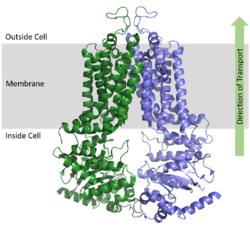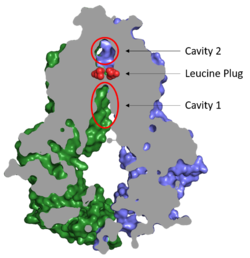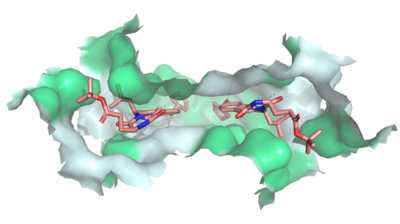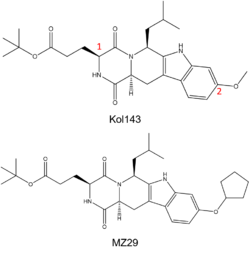ABCG2 multidrug transporter
From Proteopedia
(Difference between revisions)
(New page: ==ABCG2 Multidrug Transporter== <StructureSection load='5nj3' size='350' side='right' caption='ABCG2 Multidrug Transporter. Green represents residues in monomer A; Purple represents resi...) |
(Category:Featured in BAMBED) |
||
| (5 intermediate revisions not shown.) | |||
| Line 1: | Line 1: | ||
| + | {{BAMBED | ||
| + | |DATE=December 3, 2020 | ||
| + | |OLDID=3326278 | ||
| + | |BAMBEDDOI=10.1002/bmb.21560 | ||
| + | }} | ||
| + | |||
==ABCG2 Multidrug Transporter== | ==ABCG2 Multidrug Transporter== | ||
| Line 6: | Line 12: | ||
==Background== | ==Background== | ||
| - | The [https://en.wikipedia.org/wiki/ABCG2 ABCG2 multidrug transporter] is a membrane protein from the '''A'''TP-'''B'''inding '''C'''assette [https://en.wikipedia.org/wiki/ATP-binding_cassette_transporter (ABC)] transporter family, specifically the G-subfamily. Also known as the breast cancer resistance protein (BCRP), ABCG2 has physiological roles in various tissue cells including the [https://en.wikipedia.org/wiki/Mammary_gland mammary gland] and the [https://en.wikipedia.org/wiki/Blood%E2%80%93brain_barrier blood-brain], [https://en.wikipedia.org/wiki/Blood%E2%80%93testis_barrier blood-testis], and [https://en.wikipedia.org/wiki/Placenta maternal-fetal] barriers.<ref name="Taylor">PMID:28554189</ref> ABCG2 protects cells by exporting [https://en.wikipedia.org/wiki/Xenobiotic xenobiotic] molecules out of the cell using ATP hydrolysis. ABCG2 also affects the [https://en.wikipedia.org/wiki/Pharmacokinetics pharmacokinetics] of many drugs and contributes to [https://en.wikipedia.org/wiki/Multiple_drug_resistance multidrug resistance].<ref name="Manolaridis">PMID:30405239</ref> ABCG2 belongs to the family of 48 transporter proteins called ATP-binding cassette transporters (ABC transporters). A high percentage of the ABC family transporters (19 of the 48) transport [https://en.wikipedia.org/wiki/List_of_chemotherapeutic_agents chemotherapeutic agents] out of cells, making expression levels of ABC transporters a major indicator of cancer treatment prognosis.<ref name="Robey">PMID:29643473</ref> | + | The [https://en.wikipedia.org/wiki/ABCG2 ABCG2 multidrug transporter] or '''abc subfamily G member 2''' is a membrane protein from the '''A'''TP-'''B'''inding '''C'''assette [https://en.wikipedia.org/wiki/ATP-binding_cassette_transporter (ABC)] transporter family, specifically the G-subfamily. Also known as the breast cancer resistance protein (BCRP), ABCG2 has physiological roles in various tissue cells including the [https://en.wikipedia.org/wiki/Mammary_gland mammary gland] and the [https://en.wikipedia.org/wiki/Blood%E2%80%93brain_barrier blood-brain], [https://en.wikipedia.org/wiki/Blood%E2%80%93testis_barrier blood-testis], and [https://en.wikipedia.org/wiki/Placenta maternal-fetal] barriers.<ref name="Taylor">PMID:28554189</ref> ABCG2 protects cells by exporting [https://en.wikipedia.org/wiki/Xenobiotic xenobiotic] molecules out of the cell using ATP hydrolysis. ABCG2 also affects the [https://en.wikipedia.org/wiki/Pharmacokinetics pharmacokinetics] of many drugs and contributes to [https://en.wikipedia.org/wiki/Multiple_drug_resistance multidrug resistance].<ref name="Manolaridis">PMID:30405239</ref> ABCG2 belongs to the family of 48 transporter proteins called ATP-binding cassette transporters (ABC transporters). A high percentage of the ABC family transporters (19 of the 48) transport [https://en.wikipedia.org/wiki/List_of_chemotherapeutic_agents chemotherapeutic agents] out of cells, making expression levels of ABC transporters a major indicator of cancer treatment prognosis.<ref name="Robey">PMID:29643473</ref> |
Using [https://en.wikipedia.org/wiki/Cryogenic_electron_microscopy cryoelectron microscopy] (cryo-EM), the two cavity substrate transport structure (<scene name='83/832932/Highlight_cavity_1/3'>Cavity 1</scene>; <scene name='83/832932/Atp_bound_use_cav_2/3'>Cavity 2</scene>), inward facing nucleotide binding domain (<scene name='83/832932/Overall_structure_nbd_unbound/6'>NBD</scene>), and condensed extracellular loop 3 (<scene name='83/832939/El-3/3'>EL-3</scene>) structure of ABCG2 have been elucidated. These structures also illustrated the transporter cycle of ABCG2, the binding locations for inhibitors, and the link between cancer and the ABC transporter family.<ref name="Taylor"/><ref name="Manolaridis"/><ref name="Jackson">PMID:29610494</ref> | Using [https://en.wikipedia.org/wiki/Cryogenic_electron_microscopy cryoelectron microscopy] (cryo-EM), the two cavity substrate transport structure (<scene name='83/832932/Highlight_cavity_1/3'>Cavity 1</scene>; <scene name='83/832932/Atp_bound_use_cav_2/3'>Cavity 2</scene>), inward facing nucleotide binding domain (<scene name='83/832932/Overall_structure_nbd_unbound/6'>NBD</scene>), and condensed extracellular loop 3 (<scene name='83/832939/El-3/3'>EL-3</scene>) structure of ABCG2 have been elucidated. These structures also illustrated the transporter cycle of ABCG2, the binding locations for inhibitors, and the link between cancer and the ABC transporter family.<ref name="Taylor"/><ref name="Manolaridis"/><ref name="Jackson">PMID:29610494</ref> | ||
| Line 18: | Line 24: | ||
When ATP binds, α-helices in the NBD <scene name='83/832932/Atp_bound_nbd/3'>rotate</scene> approximately 35° relative to the <scene name='83/832932/Overall_structure_nbd_unbound/5'>inward-facing conformation of NBD</scene>. This shift in the NBD causes slight shifts of α-helices in the TMD; these helices are <scene name='83/832932/Atp_bound_use_tmd/4'>pushed toward each other</scene> relative to the <scene name='83/832932/Overall_structure_tmd_unbound/4'>inward-facing conformation of TMD</scene>. The overall shift from inward-facing to outward-facing promotes the transport of substrates through the transporter.<ref name="Manolaridis"/> | When ATP binds, α-helices in the NBD <scene name='83/832932/Atp_bound_nbd/3'>rotate</scene> approximately 35° relative to the <scene name='83/832932/Overall_structure_nbd_unbound/5'>inward-facing conformation of NBD</scene>. This shift in the NBD causes slight shifts of α-helices in the TMD; these helices are <scene name='83/832932/Atp_bound_use_tmd/4'>pushed toward each other</scene> relative to the <scene name='83/832932/Overall_structure_tmd_unbound/4'>inward-facing conformation of TMD</scene>. The overall shift from inward-facing to outward-facing promotes the transport of substrates through the transporter.<ref name="Manolaridis"/> | ||
| + | |||
| + | How the movement of the NBDs is linked to the movement of the transdomain movements is nicely visible in this <scene name='86/869419/Animation/2'>superposition</scene>.{{Template:Button Toggle Animation2}} | ||
The NBDs in ABCG2 remain in contact with one another even without a bound substrate, providing greater substrate specificity as the entrance to the transporter is not as globular as other ABC transporters like ABCB1 or ABCC1. The entrance from the cytoplasm to the transporter is lined by [https://en.wikipedia.org/wiki/Hydrophobe hydrophobic] residues<scene name='83/832939/Lining_of_entrance_of_nbd/1'> A397, V401, L405, L539, I543 and T547</scene> in both [https://en.wikipedia.org/wiki/Monomer monomers]. | The NBDs in ABCG2 remain in contact with one another even without a bound substrate, providing greater substrate specificity as the entrance to the transporter is not as globular as other ABC transporters like ABCB1 or ABCC1. The entrance from the cytoplasm to the transporter is lined by [https://en.wikipedia.org/wiki/Hydrophobe hydrophobic] residues<scene name='83/832939/Lining_of_entrance_of_nbd/1'> A397, V401, L405, L539, I543 and T547</scene> in both [https://en.wikipedia.org/wiki/Monomer monomers]. | ||
| Line 59: | Line 67: | ||
Jaelyn Voyles | Jaelyn Voyles | ||
| + | |||
| + | [[Category:Featured in BAMBED]] | ||
Current revision
This page, as it appeared on December 3, 2020, was featured in this article in the journal Biochemistry and Molecular Biology Education.
ABCG2 Multidrug Transporter
References
- ↑ 1.0 1.1 1.2 1.3 1.4 1.5 1.6 1.7 Taylor NMI, Manolaridis I, Jackson SM, Kowal J, Stahlberg H, Locher KP. Structure of the human multidrug transporter ABCG2. Nature. 2017 Jun 22;546(7659):504-509. doi: 10.1038/nature22345. Epub 2017 May, 29. PMID:28554189 doi:http://dx.doi.org/10.1038/nature22345
- ↑ 2.0 2.1 2.2 2.3 2.4 2.5 2.6 2.7 2.8 2.9 Manolaridis I, Jackson SM, Taylor NMI, Kowal J, Stahlberg H, Locher KP. Cryo-EM structures of a human ABCG2 mutant trapped in ATP-bound and substrate-bound states. Nature. 2018 Nov;563(7731):426-430. doi: 10.1038/s41586-018-0680-3. Epub 2018 Nov, 7. PMID:30405239 doi:http://dx.doi.org/10.1038/s41586-018-0680-3
- ↑ 3.0 3.1 3.2 3.3 Robey RW, Pluchino KM, Hall MD, Fojo AT, Bates SE, Gottesman MM. Revisiting the role of ABC transporters in multidrug-resistant cancer. Nat Rev Cancer. 2018 Jul;18(7):452-464. doi: 10.1038/s41568-018-0005-8. PMID:29643473 doi:http://dx.doi.org/10.1038/s41568-018-0005-8
- ↑ 4.0 4.1 4.2 4.3 Jackson SM, Manolaridis I, Kowal J, Zechner M, Taylor NMI, Bause M, Bauer S, Bartholomaeus R, Bernhardt G, Koenig B, Buschauer A, Stahlberg H, Altmann KH, Locher KP. Structural basis of small-molecule inhibition of human multidrug transporter ABCG2. Nat Struct Mol Biol. 2018 Apr;25(4):333-340. doi: 10.1038/s41594-018-0049-1. Epub, 2018 Apr 2. PMID:29610494 doi:http://dx.doi.org/10.1038/s41594-018-0049-1
- ↑ Marzac C, Garrido E, Tang R, Fava F, Hirsch P, De Benedictis C, Corre E, Lapusan S, Lallemand JY, Marie JP, Jacquet E, Legrand O. ATP Binding Cassette transporters associated with chemoresistance: transcriptional profiling in extreme cohorts and their prognostic impact in a cohort of 281 acute myeloid leukemia patients. Haematologica. 2011 Sep;96(9):1293-301. doi: 10.3324/haematol.2010.031823. Epub, 2011 May 23. PMID:21606172 doi:http://dx.doi.org/10.3324/haematol.2010.031823
- ↑ Bartholomae S, Gruhn B, Debatin KM, Zimmermann M, Creutzig U, Reinhardt D, Steinbach D. Coexpression of Multiple ABC-Transporters is Strongly Associated with Treatment Response in Childhood Acute Myeloid Leukemia. Pediatr Blood Cancer. 2016 Feb;63(2):242-7. doi: 10.1002/pbc.25785. Epub 2015 Oct, 29. PMID:26512967 doi:http://dx.doi.org/10.1002/pbc.25785
- ↑ Mohelnikova-Duchonova B, Brynychova V, Oliverius M, Honsova E, Kala Z, Muckova K, Soucek P. Differences in transcript levels of ABC transporters between pancreatic adenocarcinoma and nonneoplastic tissues. Pancreas. 2013 May;42(4):707-16. doi: 10.1097/MPA.0b013e318279b861. PMID:23462326 doi:http://dx.doi.org/10.1097/MPA.0b013e318279b861
- ↑ Mao Q, Unadkat JD. Role of the breast cancer resistance protein (BCRP/ABCG2) in drug transport--an update. AAPS J. 2015 Jan;17(1):65-82. doi: 10.1208/s12248-014-9668-6. Epub 2014 Sep 19. PMID:25236865 doi:http://dx.doi.org/10.1208/s12248-014-9668-6
- ↑ Leonard GD, Fojo T, Bates SE. The role of ABC transporters in clinical practice. Oncologist. 2003;8(5):411-24. doi: 10.1634/theoncologist.8-5-411. PMID:14530494 doi:http://dx.doi.org/10.1634/theoncologist.8-5-411
- ↑ Binkhathlan Z, Lavasanifar A. P-glycoprotein inhibition as a therapeutic approach for overcoming multidrug resistance in cancer: current status and future perspectives. Curr Cancer Drug Targets. 2013 Mar;13(3):326-46. doi:, 10.2174/15680096113139990076. PMID:23369096 doi:http://dx.doi.org/10.2174/15680096113139990076
- ↑ Witherspoon SM, Emerson DL, Kerr BM, Lloyd TL, Dalton WS, Wissel PS. Flow cytometric assay of modulation of P-glycoprotein function in whole blood by the multidrug resistance inhibitor GG918. Clin Cancer Res. 1996 Jan;2(1):7-12. PMID:9816083
- ↑ Allen JD, van Loevezijn A, Lakhai JM, van der Valk M, van Tellingen O, Reid G, Schellens JH, Koomen GJ, Schinkel AH. Potent and specific inhibition of the breast cancer resistance protein multidrug transporter in vitro and in mouse intestine by a novel analogue of fumitremorgin C. Mol Cancer Ther. 2002 Apr;1(6):417-25. PMID:12477054
- ↑ Weidner LD, Zoghbi SS, Lu S, Shukla S, Ambudkar SV, Pike VW, Mulder J, Gottesman MM, Innis RB, Hall MD. The Inhibitor Ko143 Is Not Specific for ABCG2. J Pharmacol Exp Ther. 2015 Sep;354(3):384-93. doi: 10.1124/jpet.115.225482. Epub , 2015 Jul 6. PMID:26148857 doi:http://dx.doi.org/10.1124/jpet.115.225482
Student Contributors
Julia Pomeroy
Shelby Skaggs
Sam Sullivan
Jaelyn Voyles
Proteopedia Page Contributors and Editors (what is this?)
Karsten Theis, Angel Herraez, R. Jeremy Johnson, Michal Harel




